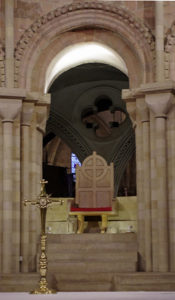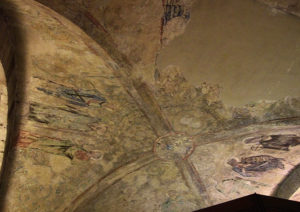Norwich Cathedral is spectacular and really does take your breath away. Walking into the nave, the first impression is of height and length. Only St Alban’s is longer. Arcade pillars and rounded Norman arches with dog tooth carving soar up to the vaulted ceiling. This replaced the original wood ceiling which was destroyed by fire in the C15th which explains the difference in the colour of the stone. It is a wonderful example of a Lierne vaulted ceiling with carved bosses at the intersections of the ribs. These begin with the Old Testament by the choir and end with the Last Judgement at the west end.
The Great West Window tracery dates from the mid C15th. The stained glass is Victorian and placed here in 1854. There was an immediate outcry after it was put in and it was painted over with brown varnish. It remained like this until the 1970s when the varnish was removed and the window restored. The glass is still bright, even on a dull day. At the top are scenes from the life of Christ and below are corresponding scenes from the life of Moses.
During Baptisms, the copper font is moved under the boss of the Baptism of Christ. This was originally used for boiling up chocolate in the Rowntree’s Factory in Norwich and was given to the cathedral when factory closed in 1997.
The Chantry Chapel of Bishop Richard Nykke, the last Bishop before the Dissolution of the Monasteries, can be recognised by the elaborate carved roof below two bays on the south arcade near the nave altar. It only used for two years as all chantry chapels were destroyed after the Dissolution.
Near this in the south aisle is the remains of an early Medieval wall painting depicting Bishop Herbert de Losinga. At the bottom, he is petitioning William I to buy the Bishopric. Above he has made a pilgrimage to Rome to make penance and seek forgiveness of the Pope. This was given and he returned to build his cathedral. This is the earliest representation of Norwich Cathedral to survive.
By the nave altar are two spirally carved round pillars. There were originally four but two were altered after the fire in 1463. These marked the position of the Medieval nave altar. The nave was used by the town. The Choir and Presbytery were used by the monks.
The carved stone nave pulpit dates from the end of the C19th.
Above the stone screen separating the nave and choir is the organ. Although some of the organ pipes are C17th, the organ itself dates from 1899. The organ case was made in 1950.
The canopies above the choir stalls are the original C15th Perpendicular carvings. The actual stalls themselves are C19th and are made from paler wood. The Bishop’s throne is also C19th and was designed by JL Pearson.
There are two rows of original C15th stalls in front of the transepts, still with their misericords. These are all secular carvings and there is a lovely one of a schoolmaster smacking the bare bottom of a naughty school boy.
The Chantry Chapel of St James with the tomb of Bishop James Goldwell, who was responsible for the Presbytery roof, is between the choir and the south ambulatory. The tomb canopy is as brightly coloured as it would have been when built. His effigy is the only medieval effigy to survive.
A short flight of steps behind the pelican lectern lead to the presbytery with its rounded Norman apse. The glorious clerestory with its stained glass windows was added in 1362 after the spire blew down and damaged the east end. The stone vaulted ceiling was the work of Bishop James Goldwell in the C15th and was a bit of an ego trip on his part as all the the carved bosses have small angels holding gold wells.
In front of the high altar is the C16th stone slab commemorating Herbert de Losinga, the founder of the Cathedral and replaces the original memorial. Beyond it is a bas relief of him, placed here to commemorate the Cathedral’s 900 anniversary.
Sitting at the top of a flight of steps overlooking the altar are the remains of the original Bishop’s throne dating from the C8th cathedral of North Elmham. The two stones survived fire and exposure to the elements and are all that is left of the oldest bishop’s throne still in use in any English cathedral. They have been incorporated into the seat of a modern wood chair designed to be as close to the original as possible.
The ambulatory runs round the outer edge of the choir and Presbytery and has three chapels off. Most of the medieval stained glass was destroyed during the Reformation. The remaining pieces have been collected and placed in a window in the north ambulatory.
The simple Chapel of St Andrew off the north transept has blind Norman arcading around the walls and a small C14th painting of the crucifixion behind the modern stone altar.
The Jesus Chapel is a small semi-circular chapel off the north ambulatory with much more elaborate arcading with carved capitals with the remains of wall paintings. The stone altar slab is a rare Norman survivor. Above it is a painting of the Adoration of the Magi dating from the 1480s.
St Saviour’s Chapel was built in 1932 on the site of the Lady Chapel which was destroyed in the time of Elizabeth I. It is dedicated to the Norfolk Regiment and their standards hang from the roof. The painted panels of the reredos came from the redundant church of St Michael at Plea.
The stained glass windows have images of East Anglian saints, including Julian of Norwich the C14th anchorite in St Julian’s Church on King Street. She was a well educated noblewoman and wrote her book “The Revelations of Divine Love” after a series of visions. This depicts a God of Love and very different from the Medieval image of a hell fire and damnation.
Opposite the entrance to St Saviour’s Chapel and beneath the apse with the Bishop’s chair is a small niche which would have been used to display relics. A square hole at the back was designed so that the Holy Aura could waft upwards and inspire the bishop sitting above.
St Luke’s Chapel is off the south ambulatory. Behind the altar is a late C14th painting, known as the Despenser Reredos, named after the Bishop of Norwich, Henry le Despenser. His forces successfully contained the Peasants’ Revolt of 1381 in Norfolk and the painting was probably commissioned in thanksgiving. The five panels depict scenes from the Crucifixion to the Resurrection. The reredos was re-discovered in 1847, having been reversed and used as a table top. The top section was damaged and only the top of the central section showing Christ in Majesty has been restored. The rest have been left.
The Victorian stained glass window has representations of St Luke. At the top is Luke the doctor tending the sick. In the centre is Luke the artist as he is believed to have painted a portrait of the Virgin Mary and is the patron saint of artists. At the bottom is luke the evangelist , writing his gospel along with his symbol of a winged ox.
The C15th stone medieval font came from St Mary in the Marsh church, which stood in the cathedral close. example of a seven sacrament font. These were very popular in East Anglia. Above it is a Chrismatory made of silver gilt and glass. It contains three vials containing the Holy oils used to anoint to sick or dying, for use in baptism and for use in the ordination of priest and consecration of bishops.
Directly north of the high altar and spanning the ambulatory around the presbytery is the reliquary arch. The relics had originally been kept in a small niche in the ambulatory under the Bishop’s Chair. It is likely this was built after the riots of 1272 to keep the relics safe from further disturbances. The relics could include the bones of a saint or holy person, fragments of their clothing or some of their possessions.
The room is reached by a steep stone staircase and now houses the Cathedral Treasury and contains silver and silver gilt chalices, communion plate and spoons from churches across Norfolk. The ceiling has the most extensive collection of surviving wall paintings within the cathedral, dating from the C14th.
There is more information and a lot more pictures “here.”:http://wasleys.org.uk/eleanor/churches/england/norfolk/norwich_cathedral/index.html









